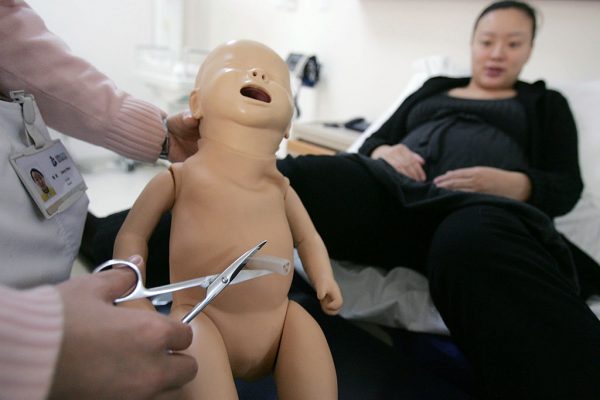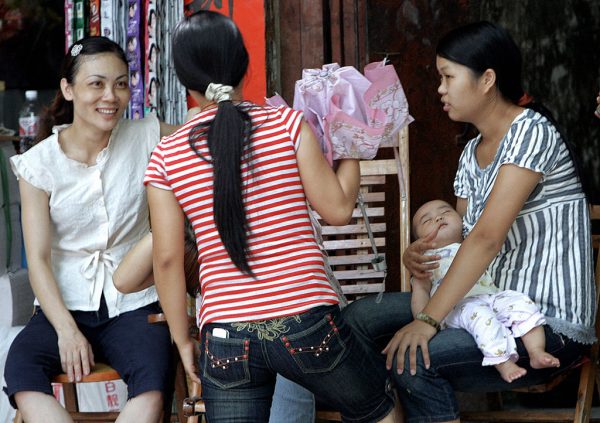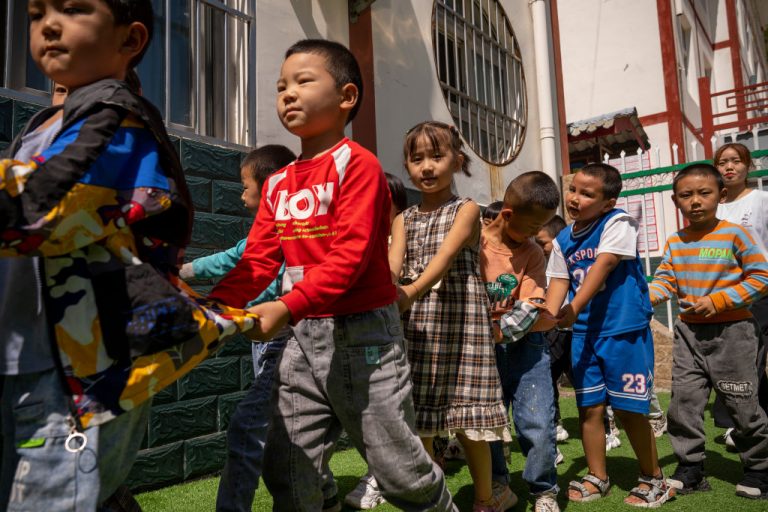On September 27, China’s State Council issued the Outline for the Development of Chinese Women (2021-2030), which mentions the need to “reduce the number of non-medically necessary abortions.”
The number of abortions in China has been high for years, due to the decades long implementation and enforcement of a one-child policy on the mainland. This policy lead to a large number of women being forced to have abortions. The current lack of knowledge about sex and reproductive education in China has also lead to a large number of abortions.
When the new outline was published there were many different interpretations of the document. While some are waiting to see what will happen, others believe that there is no need to read too much into it in advance. Others see it as another attempt to impose the government’s population control policies on women with no, or little intention, to bear a child.
Reducing non-medically necessary abortions
On September 27, China’s State Council issued the Outline for the Development of Chinese Women (2021-2030) and the Outline for the Development of Chinese Children (2021-2030), requiring all provinces, autonomous regions and municipalities directly under the central government to implement them. The full text is more than 50,000 words long, including measures to “improve the protection of women’s health,” “strengthen the maternal and child health service system,” and to “ensure safe maternal delivery” as well as other objectives.
However, one sentence caught the media’s attention; “Reduce the number of non-medically necessary abortions.”
Success
You are now signed up for our newsletter
Success
Check your email to complete sign up
When the notice came out, Chinese social media lit up. How should this short sentence be interpreted?
On NetEase News, which is relatively lax in its comment control, a single post on the topic drew more than 40,000 comments, almost all of them cynical and sarcastic. Many comments made fun of the government for its violent birth control policies and criticized a government that is now showing signs that authorities will be implementing forced births.
“The next condoms will be available by lottery,” and “the director of menstruation will be here soon,” one commenter teased. Some people accused the government of “doing whatever it takes to get what it wants,” while others said, “Don’t worry, I won’t have a baby even if you beg on your knees!”
The Sina Weibo discussion on this topic is also diverse, with a wide range of opinions. Some readers believe that the new policies are being implemented to reduce the problem of young people getting pregnant before marriage, while others believe that “the state will first put the word out to see how the public opinion will turn, and then choose the opportunity to explain.”

The Chinese government’s seventh census, released on May 10 of this year, announced that the country’s population totaled 1.41 billion. The census indicates an average population growth rate of 0.04 percent which is lower than over the past decade. Demographics over the previous decade saw a decline in both the working-age population and the population of women of childbearing age.
According to the census bulletin, China’s population aged 60 and above is 264 million, accounting for 18.7 percent of the population, up 5.44 percentage points compared to a decade ago. With the population in China aging, it’s expected that China will continue to face the pressure of long-term balanced population development in the coming years.
Ning Jizhe, director of the Bureau of Statistics, said, “The proportion of the elderly population is rising faster, and aging has become the basic national condition of China for a period of time in the future.”
In August, the Standing Committee of the Chinese People’s Congress passed a decision on amending the Population and Family Planning Law, advocating marriage and childbirth at the right age, and announcing that a couple can now have upwards of three children, marking the official entry of the “three-child” fertility policy into law.
Zhang Jing, founder of the New York-based NGO, China Women’s Rights, believes that the so-called “reduction of non-medically necessary abortions” will be yet another coercive policy by the Chinese government to encourage childbirth.
She told Voice of America, “Now that there are fewer people, there is not enough population, there is a shortage of young people, they are doing it again. Here comes the coercion again. In short, the whole process is because he wants to implement one of his policies and does not have the welfare of women, the people, in mind. Human rights were never in the forefront of his mind. That’s why he came back with such forcefulness. So as Chinese women, it is really unfortunate.”
Demographer Yi Fu-hsien, author of “The Empty Nest in the Big Country,” argues that the details are not yet available in China, so there is no need to read too much into it. He told Voice of America that the attitude toward abortion should be related to the population policy.
He said, “In the past, China regarded population as a burden and implemented the one-child policy, which not only encouraged abortion by individuals, but also involved the government in forcing abortions, and abortion advertisements were all over the streets. Now that the population policy has begun to change and is gradually shifting from ‘treating the population as a burden’ to ‘respecting life,’ it is inevitable that abortion will be regulated and will not be treated as child’s play as it was in the past. The international community should respect, not blame, the Chinese authorities for this shift.”

A history of forced abortions
China has one of the highest abortion and repeat abortion rates in the world, and abortions in China tend to be performed at a younger age.
The China Population and Development Research Center, a subsidiary of China’s National Population and Family Planning Commission — abolished in 2018 and later merged with the Ministry of Health to become China’s National Health and Wellness Commission — published a long WeChat public article in early 2020 stating that China had 9.62 million abortions recorded in 2017, accounting for about 17.4 percent of all abortions worldwide.
Among women who had abortions, the rate of repeat abortions was as high as 56.4 percent in some regions. Among the group receiving abortions, 47.5 percent of women were under 25 years of age, 49.7 percent were unmarried women, and 55.9 percent were those with more than two abortions. However, this article mentions that the actual number of abortions in China is around 13 million per year, according to a study by Wu Shangchun of the Research Institute of the Family Planning Commission, because official statistics do not include private hospitals and clinics.
The article says that more than half of the women who have abortions are between 20 and 30 years old, which may be related to the rapid urbanization of China and the increasing number of young people from rural areas moving into cities. This age group has a highly mobile population and an open sexual mindset leading to an active sex life, yet there is an extreme lack of knowledge about sex, particularly about topics such as contraception and birth control.

However, China’s family planning policy, which began in the late 1970s and was gradually liberalized in 2011, has led to a large number of involuntary abortions and, in some rural areas, even forced women to have late-term induced abortions, causing severe physical and psychological trauma.
In April of 2011, in Guanxian County, Shandong Province, the notorious “100-day childless” campaign took place. In April of that year, Shandong’s Guanxian County was warned by its superiors for being behind in family planning. Zeng Zhaoqi, then secretary of the county party committee, launched the “100 Days of No Children” campaign, demanding that from May 1 to August 10, no child be born in the county. During these three months, all pregnant women, whether planned or unplanned, first, second or third, were arrested and induced to abort.
According to the China Health Statistics Yearbook 2010, the total number of induced abortions in China between 1980 and 2009 was 275,413,456. How many of the 275 million induced abortions were performed voluntarily and how many were performed under duress is a secret that no one can tell, or will ever know the answer to.
On May 23, 2008, Zhang Wenfang, a villager in Longkou Township, Honghu City, Hubei Province, was forcibly taken to the hospital by the local family planning cadres for an induced abortion when she was 9 months pregnant and about to give birth.
Two days later, Zhang Wenfang lost consciousness after being administered a hypodermic injection and woke up having lost her child. The hospital did not notify her family and Zhang did not know where her child had gone. What’s more frightening is that when Zhang had a medical checkup a few months later, she found that her uterus and right ovary had been removed. Zhang, who was deeply traumatized, has been disabled ever since and is still unable to leave her wheelchair.
Zhang Wenfang, who is still fighting for her pension, can only sigh deeply when she talks about what happened to her and the recent reversal of the birth control policy.
She told Voice of America, “As ordinary people, what can we think? These things, women’s rights, are not really defended and protected. I was nine months pregnant, and I was in labor when they did this. I gave birth on those days, and then my baby was not seen alive or dead until today. I’d say that’s my eternal nightmare. I can never get over this hurdle in my heart. I can only endure, gritting my teeth, heart dripping blood, slowly living their own life.”
Chen Guangcheng, a lawyer in Linyi, Shandong province, who was persecuted by the local government for his concern about violent birth control and his advocacy on behalf of victims, fled China in 2012 and now lives in the United States. In an interview with the Voice of America, Chen said that non-medically necessary abortions are essentially what it would take to ban all abortions.
He said, “On the one hand, the Chinese Communist Party adjusts its so-called policies to meet its needs, but in fact, it changes them overnight. There is no long-term strategic consideration. If you have a baby today, you’re breaking the law, but if you don’t have a baby tomorrow, you can’t. This is the situation, just say, swinging from side to side. It’s a mess, a mess. Just like when you want to give birth to a child, you do not have a birth certificate, no hospital or unit can help deliver the baby. If you help deliver a baby that is a violation of the Communist Party’s taboo, and will be punished. This is actually a manifestation of the authoritarian regime’s arbitrary deprivation of citizens’ basic rights.”

How to reduce abortions and whether it works
Data from China’s National Health Commission shows that despite the authorities allowing “full two-child” access from 2016, the average number of abortions per year between 2014 and 2018 was 9.7 million. In the Women’s Development Program issued by the State Council on Sept. 27, in addition to the notable “reduction of non-medically necessary abortions,” it also mentions “integrating reproductive health services into the whole process of women’s health management and guaranteeing women’s right to make their own informed choices about contraception and birth control.”
Who will specify whether an abortion is “medically necessary” or not, and how would these policies reduce the occurrence of abortion? It is clear that more explanation is needed.
Demographer Yi Fuxian does not believe China will ban abortion altogether. He told Voice of America, “Although China will regulate abortion, it will not be as strict as the U.S. and Australia are now, much less ban abortion, and individuals will still have a lot of freedom while protecting life. Nor should it be over-interpreted by the outside world. If China does some exploration of its population policy without violating human rights, the international community should encourage it, and it will provide a lesson for other countries. Fertility decline is a global trend; Japan has a fertility rate of only 1.3 despite encouraging fertility. Taiwan and Korea have only 0.8-0.9, and the U.S. has dropped from 2.12 in 2007 to 1.64 in 2020. all need to explore ways to raise fertility.”
Education, health care and housing, which Chinese netizens call the “Three Great Mountains,” are considered by many to be the main reasons why today’s youth are reluctant to have children. It will take time to see if the Chinese government’s recent efforts to overhaul the education and training industry — which were implemented in an attempt to alleviate parents’ anxiety about educating their children — will be successful.
Zhang Jing of Women’s Rights in China feels that once the Chinese government makes up its mind, it can execute its will with great vigor. She said, “China has been making such drastic changes to all sectors of the economy for a long time, and it is very fast and furious, and when the top says something, the bottom will move immediately. And once moved up is dead and buried, there is no room to turn back. For example, the education and training industry, a word from the top, the following immediately move up, cut cleanly. So I think they will be bold, and will quickly move up. It is not difficult to move this, because the one-child policy in China has been forty years. So as soon as an order comes down, all women who want to have an abortion, or want to terminate a pregnancy, immediately the doctors inside the hospital will not give it. Whoever gives it will be responsible for it, and whose salary and bonus will be deducted. This way, no one dares to move it.”
She continued, “I am not optimistic at all, if the Chinese Communist Party enforces this policy, enforces the birth policy, forbids abortion, forbids abortion at the will of women, I do not know how serious the consequences are, but I am sure of one thing, at present young women are not willing to have more children, and will try to find contraceptive methods. I don’t know the extent of the consequences, but I am sure that young women are not willing to have more children and will try to find ways to prevent pregnancy. So, when you get pregnant, maybe the black market abortion, or the black market drugs, will be popular again, and that is very harmful to women.”














